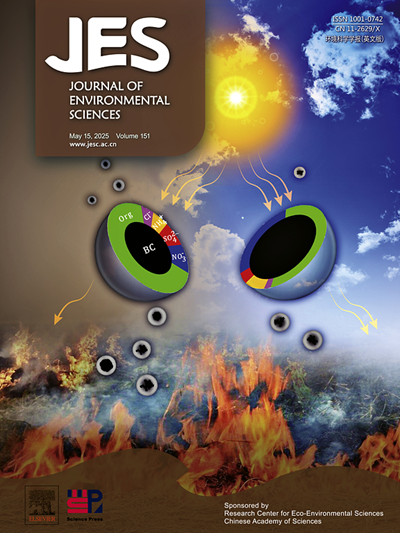IF 5.9
2区 环境科学与生态学
Q1 ENVIRONMENTAL SCIENCES
引用次数: 0
摘要
本研究旨在考察封闭砷矿中潜在有毒元素(PTEs)的营养传递。研究分析了 "土壤-植物-叶屑-蚯蚓-顶层捕食者(当地散养鸡和野生雀鸟)"系统中八种潜在有毒元素的氮和碳稳定同位素、潜在有毒元素浓度、生物累积因子(BAF)和转移因子(TF)。从地质累积指数(Igeo)、污染指数(PI)和潜在生态风险指数(RI)可以看出,矿区土壤中的 PTE 浓度普遍高于邻近对照区,其中土壤中的砷和镉浓度高于其他六种 PTE。相对较高的 BAF 值和 TF 值表明,PTEs 在土壤-植物-落叶层-蚯蚓系统中存在明显的生物转移。除蚯蚓外,BAF 值大多为 <1,表明蚯蚓吸收这些金属的能力很强。TFs在不同的PTEs和生物种类之间存在差异,例如蕨类植物和蕨类植物对As的转移能力最高,蕨类植物对Cd的转移能力最高,苔藓对Pb、Cr和Mn的转移能力最高。就本地土鸡和野生雀鸟而言,胃内容物和羽毛中的 PTE 含量高于体内组织(胃、肝脏和心脏),而肌肉和蛋中的 PTE 含量较低。从分解者蚯蚓到初级生产者植物,再到顶级捕食者,PTEs 的生物累积量普遍下降,这表明在陆地食物链的较高营养级中存在潜在的生物稀释趋势。本文章由计算机程序翻译,如有差异,请以英文原文为准。

Distribution and biotransfer of potentially toxic elements in a terrestrial ecosystem from an abandoned realgar mine
The present study was conducted to examine the trophic transfer of potentially toxic elements (PTEs) in a closed arsenic mine. Eight PTEs in a soil-plant-leaf litter-earthworm-top predators (free-range local chicken and wild passerine bird) system were analyzed for nitrogen and carbon stable isotopes, PTE concentrations, bioaccumulation factors (BAFs), and transfer factors (TFs). The PTE concentrations in soils from mining areas were generally higher than a adjacent controlled area, with As and Cd in soils showing the prominent compared to other six PTEs, as seen for the indices of geo-accumulation index (Igeo), pollution index (PI) and potential ecological risk index (RI). The relatively high BAF and TF values suggested a distinct biotransfer of PTEs along the soil-plant-leaf litter-earthworm system. BAFs were mostly <1 except in earthworms, indicating that earthworms had a strong capacity to take up these metals. The TFs varied both among PTEs and organism's species, e.g., the transfer capacities of As in Pteris vittata and Pteris cretica, Cd in Miscanthus sinensis, and Pb, Cr and Mn in moss were the highest. For local free-range chicken and wild passerine bird, the concentrations of PTEs were higher in gastric contents and feather than in internal tissue (stomach, liver and heart), with lower contents in muscle and egg. Bioaccumulation of PTEs generally decreased from decomposer earthworms, to primary producer plants, to top predator, indicating a potential bio-dilution tendency in higher trophic levels in the terrestrial food chain.
求助全文
通过发布文献求助,成功后即可免费获取论文全文。
去求助
来源期刊

Journal of Environmental Sciences-china
环境科学-环境科学
CiteScore
13.70
自引率
0.00%
发文量
6354
审稿时长
2.6 months
期刊介绍:
The Journal of Environmental Sciences is an international journal started in 1989. The journal is devoted to publish original, peer-reviewed research papers on main aspects of environmental sciences, such as environmental chemistry, environmental biology, ecology, geosciences and environmental physics. Appropriate subjects include basic and applied research on atmospheric, terrestrial and aquatic environments, pollution control and abatement technology, conservation of natural resources, environmental health and toxicology. Announcements of international environmental science meetings and other recent information are also included.
 求助内容:
求助内容: 应助结果提醒方式:
应助结果提醒方式:


